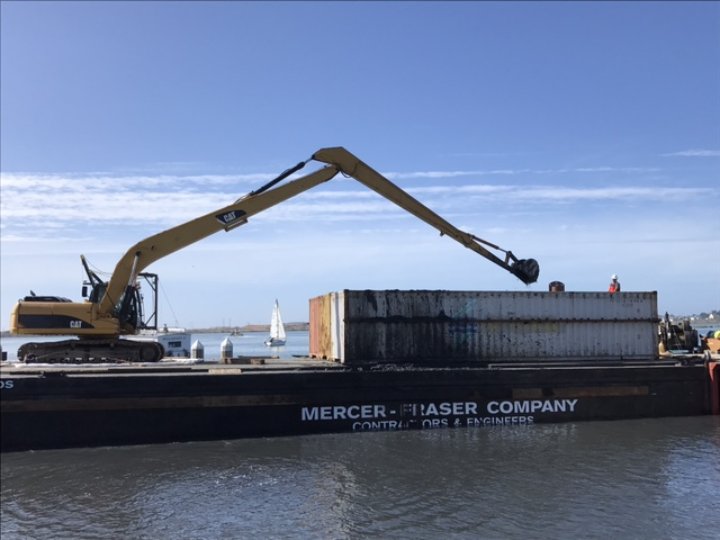Video of yesterday’s dredging efforts. | John Ferrara.
Ocean mist sprays into the air as an excavator claw plunges deep into the murky saltwater of Eureka’s Public Marina.
A 55-foot long metal arm squeals and the cab tips to one side as it reels in a mighty payload of ocean sludge. Industrial chains tighten and hold the excavator fast to its barge pedestal — keeping the machine from being pulled topsy-turvy into the bay.
The stench of tar and low tide fill the air as a mound of charcoal muck surfaces from the bubbling depths, oozing from the overflowing claw bucket and plopping back into the inky sea. The boom swings round, dumping the slush into mud splattered shipping containers, where it waits to be shipped out and dumped in the open ocean.

Dredge photos taken yesterday by John Ferrara.
For years, the sludge sat undisturbed as various government agencies bickered over how to dispose of it, leaving boaters high and dry during low tide.
The marina’s need for a dredging became so excessive, that docked boats would be run aground every low tide, rendering them useless for hours at a time.

Low tide rendered Eureka’s public marina a mud shelf. | File Photos by Richard Hendry.
But after tireless debates between the City of Eureka, the California Coastal Commission, and the Humboldt Bay Harbor Recreation & Conservation District, Eureka Parks and Recreation Director Miles Slattery told the Outpost yesterday that crews finally broke ground for the first time, and will continue to dredge the marina by excavator for the next month — one scoop at a time.
“Yes, it is extremely inefficient and expensive,” Slattery said.

If things had gone the City’s way, the silt clogging up Eureka’s Public Marina would have been sucked up with a dredge and piped out to a beach on the Samoa Peninsula — as it had been for many years.
But the Environmental Protection Agency shutdown the City’s plans in May, on the grounds that the city had previously been warned by federal regulatory agencies a decade ago, that it needed to find an alternate dumping method following the last beach dump in 2007. As a result, the City of Eureka has resorted to scooping the silt out with an excavator and dumping it into old shipping containers. From there, the watery mud will be transferred to a 1,700 7,100 yard dump scow, which will be tugged out to an area located three miles offshore — a site created specifically for the disposal of ocean dredged materials.
While the excavator is currently working at a less-than-efficient pace within the confines of the marina, Slattery told the Outpost that things should pick up as it works its way toward open water.
“When they get into the outer reaches of the marina, they’ll be able to take the excavator and dump it directly into the dump scow,” he said. “It’s a big dumpster. Its hydraulically operated belly opens up and [the sediment] dumps straight out.”

Eureka Parks and Recreation Director Miles Slattery addresses the City Council back in June. | Screenshot nabbed from City of Eureka video.
Slattery also said that the excavator was using a fairly small bucket yesterday, and that a much larger one will be attached as soon as possible for future dredging.
“We have a smaller bucket on it right now, partially because of where we’re pulling mud from,” Slattery said. “We’re going to get a bigger bucket on there so we can be more efficient, but we wanted to get started today.”
The city will be scooping against the clock for the next month, as its only permitted to dredge until October 15. The city is permitted to dispose of up to 60,000 cubic yards of material. There’s estimated to be about 2 to 3,000 55,000 cubic yards of silt piled up in the marina.

Slattery said the city might also be able to dredge the Coast Guard slip at Woodley Island Marina if there’s enough time.
“The Coast Guard ship has much draft, it causes sediment buildup at the end of the F dock, typically where their ship is.” he said. “Because of the amount of sediment, they’re in a less effective space for them to respond to emergencies. We’d like to get to that as well — time permitting.”



CLICK TO MANAGE